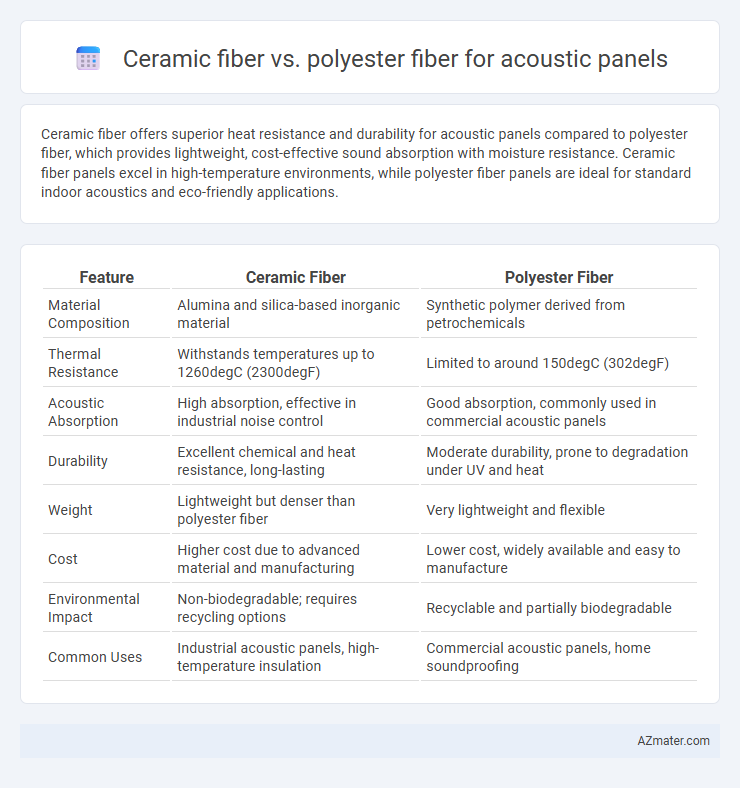Ceramic fiber offers superior heat resistance and durability for acoustic panels compared to polyester fiber, which provides lightweight, cost-effective sound absorption with moisture resistance. Ceramic fiber panels excel in high-temperature environments, while polyester fiber panels are ideal for standard indoor acoustics and eco-friendly applications.
Table of Comparison
| Feature | Ceramic Fiber | Polyester Fiber |
|---|---|---|
| Material Composition | Alumina and silica-based inorganic material | Synthetic polymer derived from petrochemicals |
| Thermal Resistance | Withstands temperatures up to 1260degC (2300degF) | Limited to around 150degC (302degF) |
| Acoustic Absorption | High absorption, effective in industrial noise control | Good absorption, commonly used in commercial acoustic panels |
| Durability | Excellent chemical and heat resistance, long-lasting | Moderate durability, prone to degradation under UV and heat |
| Weight | Lightweight but denser than polyester fiber | Very lightweight and flexible |
| Cost | Higher cost due to advanced material and manufacturing | Lower cost, widely available and easy to manufacture |
| Environmental Impact | Non-biodegradable; requires recycling options | Recyclable and partially biodegradable |
| Common Uses | Industrial acoustic panels, high-temperature insulation | Commercial acoustic panels, home soundproofing |
Introduction to Acoustic Panel Materials
Ceramic fiber and polyester fiber are common materials used in acoustic panels, each offering distinct sound absorption properties. Ceramic fiber provides excellent thermal resistance and high-frequency sound absorption, making it ideal for industrial and high-temperature environments. Polyester fiber is lightweight, moisture-resistant, and effective at absorbing mid to high-frequency sounds, commonly used in residential and commercial acoustic treatments.
Overview of Ceramic Fiber
Ceramic fiber used in acoustic panels offers superior thermal insulation and high-temperature resistance, making it ideal for industrial and specialized soundproofing applications. Its cellular structure effectively absorbs sound waves across broad frequency ranges, enhancing noise reduction capabilities compared to polyester fiber. Ceramic fiber's durability under extreme conditions outperforms polyester's susceptibility to moisture and physical degradation.
Overview of Polyester Fiber
Polyester fiber used in acoustic panels offers excellent sound absorption due to its lightweight, non-toxic, and moisture-resistant properties, making it ideal for indoor applications. It provides durability and flexibility while maintaining eco-friendliness through recyclable materials. Compared to ceramic fiber, polyester fiber panels deliver effective noise reduction without the brittleness or health hazards associated with ceramic fibers.
Acoustic Performance Comparison
Ceramic fiber offers superior heat resistance and higher sound absorption coefficients in high-frequency ranges compared to polyester fiber, making it ideal for environments requiring thermal insulation alongside acoustic control. Polyester fiber provides effective sound absorption in mid to low frequencies with greater flexibility and cost-efficiency, suitable for general indoor acoustic panels. Acoustic performance depends on specific frequency ranges and application needs, with ceramic fiber achieving higher noise reduction coefficients (NRC) typically above 0.9, while polyester fibers average around 0.7 to 0.85.
Thermal Insulation Properties
Ceramic fiber exhibits superior thermal insulation properties compared to polyester fiber, with its ability to withstand temperatures exceeding 1000degC, making it ideal for high-temperature acoustic panel applications. Polyester fiber typically offers thermal resistance up to around 130degC, limiting its effectiveness in environments with elevated heat. The low thermal conductivity of ceramic fiber significantly enhances heat retention and fire resistance in acoustic panels, whereas polyester fiber is more suited for sound absorption with moderate thermal protection.
Fire Resistance Evaluation
Ceramic fiber outperforms polyester fiber in fire resistance for acoustic panels due to its high melting point above 1000degC and excellent thermal insulation properties, making it ideal for fire safety applications. Polyester fiber, with a melting point around 250degC, tends to melt and emit toxic fumes when exposed to high heat, limiting its use in fire-resistant acoustic solutions. Evaluations by fire safety standards such as ASTM E84 demonstrate ceramic fiber's superior flame spread and smoke development ratings compared to polyester fiber.
Durability and Longevity
Ceramic fiber acoustic panels exhibit superior durability and longevity compared to polyester fiber due to their high resistance to heat, moisture, and chemical degradation. Polyester fibers tend to break down faster under prolonged exposure to humidity and UV light, reducing their effectiveness over time. The thermal stability and robust structural integrity of ceramic fiber make it a preferred choice for long-term acoustic insulation applications.
Environmental Impact and Sustainability
Ceramic fiber offers superior thermal resistance and durability but involves energy-intensive manufacturing processes with higher carbon emissions compared to polyester fiber. Polyester fiber, often made from recycled plastics, provides better recyclability and lower environmental footprint throughout its lifecycle. Choosing polyester fiber supports sustainable acoustic panel production due to its renewable input materials and reduced ecological impact.
Cost Analysis and Availability
Ceramic fiber offers superior thermal insulation but comes at a higher cost compared to polyester fiber, making it less economical for large-scale acoustic panel production. Polyester fiber is widely available, affordable, and versatile, providing adequate sound absorption for most applications while ensuring budget-friendly manufacturing. Availability of polyester fiber in bulk quantities supports faster production cycles and cost-efficient pricing, whereas ceramic fiber's limited suppliers and higher raw material costs increase overall expenses.
Conclusion: Choosing the Right Fiber for Acoustic Panels
Ceramic fiber offers superior heat resistance and excellent sound absorption at high temperatures, making it ideal for industrial acoustic panels requiring durability and fire safety. Polyester fiber provides lightweight, cost-effective sound insulation with good acoustic performance for residential and commercial spaces where moisture resistance and ease of installation are priorities. Selecting the right fiber depends on specific acoustic requirements, environmental conditions, and budget constraints, with ceramic fiber preferred for high-heat applications and polyester fiber favored for general soundproofing needs.

Infographic: Ceramic fiber vs Polyester fiber for Acoustic Panel
 azmater.com
azmater.com